
The Veil Nebula is a cloud of heated and ionized gas and dust in the constellation Cygnus.

NGC 1087 is an intermediate spiral galaxy in Cetus. The central bar/core is very small with many irregular features in the surrounding disk of material. With the many strange features of NGC 1087, its true nature is still uncertain. It has an extremely small nucleus and a very short stellar bar. Unlike most barred galaxies, the bar apparently has some new star-formation taking place. There is a multiple spiral structure defined more by the dust lanes than by luminous matter. Overall, the disc has a very low surface brightness. Even though it appears close to another galaxy, these two galaxies are not interacting and should be considered isolated from one another.

NGC 383 is a double radio galaxy with a quasar-like appearance located in the constellation Pisces. It is listed in Halton C. Arp's 1966 "The Arp Atlas of Peculiar Galaxies." Recent discoveries by the National Radio Astronomy Observatory in 2006 reveal that NGC 383 is being bisected by high energy relativistic jets traveling at relatively high fractions of the speed of light. The relativistic electrons in the jets are detected as synchrotron radiation in the x-ray and radio wavelengths. The focus of this intense energy is the galactic center of NGC 383. The relativistic electron jets detected as synchrotron radiation extend for several thousand parsecs and then appear to dissipate at the ends in the form of streamers or filaments.

NGC 7008, also known as the Fetus Nebula is a planetary nebula with a diameter of approximately 1 light-year located at a distance of 2800 light years in northern Cygnus. It was discovered by William Herschel in 1787, in Slough, England. NGC 7008 is included in the Astronomical League's Herschel 400 observing program.
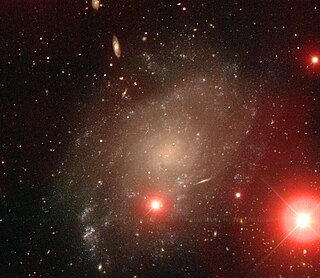
NGC 45 is a low surface brightness spiral galaxy in the equatorial constellation of Cetus. It was discovered on 11 November 1835 by the English astronomer John Herschel. The galaxy is located at a distance of 22 million light years and is receding with a heliocentric radial velocity of 466 km/s. It is located in the vicinity of the Sculptor Group, but is most likely a background galaxy.

NGC 1535 is a planetary nebula in the constellation of Eridanus, discovered by William Herschel on February 1, 1785. It is very similar to the Eskimo Nebula in both color and structure but the central star can be quite difficult to observe visually.

NGC 71 is an elliptical galaxy located in the constellation Andromeda. It is in the NGC 68 group. The galaxy was discovered by R. J. Mitchell in 1855, and observed in 1865 by Heinrich d'Arrest, who described it as "extremely faint, very small, round". The galaxy is about 110,000-130,000 light years across, making it just slightly larger than the Milky Way. The galaxy is the second largest in the NGC 68 group, after spiral galaxy NGC 70.

NGC 72 is a barred spiral galaxy estimated to be about 320 million light-years away in the constellation of Andromeda. It was discovered by R. J. Mitchell in 1855 and its magnitude is 13.5.
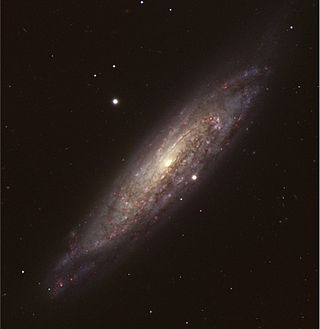
NGC 134 is a barred spiral galaxy that resembles the Milky Way with its spiral arms loosely wrapped around a bright, bar-shaped central region. Its loosely bound spiral arms categorize it as Hubble-type Sbc. It is 60 million light years away, and part of the Sculptor constellation.

NGC 84 is a star in the Andromeda constellation. It was recorded on November 14, 1884 by Guillaume Bigourdan. It is situated close to the Celestial equator, making it at least partly visible in the sky, from both hemispheres in certain times of the year. It is usually mistaken with PGC 1384.

NGC 428 is a barred spiral galaxy in the constellation of Cetus, with its spiral structure distorted and warped, possibly the result of the collision of two galaxies. There appears to be a substantial amount of star formation occurring within NGC 428 and it lacks well defined arms — a telltale sign of a galaxy merger. In 2015 the Hubble Space Telescope made a close-up shot of the galaxy with its Advanced Camera for Surveys and its Wide Field and Planetary Camera 2. The structure of NGC 428 has been compared to NGC 5645.

NGC 114 is a barred lenticular galaxy located in the constellation Cetus. It was discovered by American astronomer Truman Henry Safford on September 23, 1867. The galaxy lies approximately 195 million light-years from Earth, and is about 55,000 light-years in diameter, nearly half the size of the Milky Way.
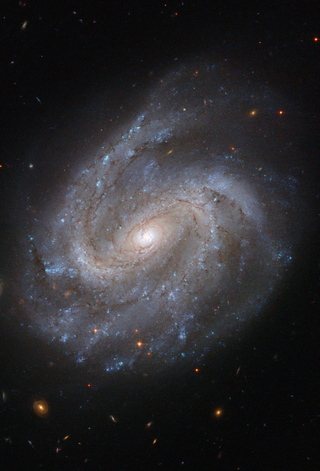
NGC 201 is a spiral galaxy in the constellation of Cetus. It is one of the group members of HCG 7, with the other group members NGC 192, NGC 196, and NGC 197. It was discovered on December 28, 1790 by William Herschel.
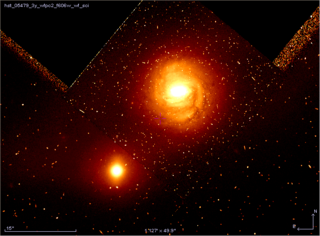
NGC 235 is a lenticular galaxy in the constellation of Cetus. Its companion, PGC 2570, appears in the line of sight of NGC 235, but has no relation with NGC 235. This pair was first discovered by Francis Leavenworth in 1886. Dreyer, the compiler of the catalogue, described the galaxy as "extremely faint, small, round, brighter middle and nucleus".

NGC 6207 is a spiral galaxy located in the constellation Hercules. It is designated as SA(s)c in the galaxy morphological classification scheme and was discovered by William Herschel on 16 May 1787. NGC 6207 is located at about 30 million light-years from Earth. It is located near the globular cluster Messier 13.

NGC 6285 is an interacting spiral galaxy located in the constellation Draco. It is classified as S0-a in the galaxy morphological classification scheme and was discovered by the American astronomer Lewis A. Swift in 1886. NGC 6285 is located at about 262 million light years away from Earth. NGC 6285 and NGC 6286 form a pair of interacting galaxies, with tidal distortions, categorized as Arp 293 in the Arp Atlas of Peculiar Galaxies

NGC 6286 is an interacting spiral galaxy located in the constellation Draco. It is designated as Sb/P in the galaxy morphological classification scheme and was discovered by the American astronomer Lewis A. Swift on 13 August 1885. NGC 6286 is located at about 252 million light years away from Earth. NGC 6286 and NGC 6285 form a pair of interacting galaxies, with tidal distortions, categorized as Arp 293 in the Arp Atlas of Peculiar Galaxies.
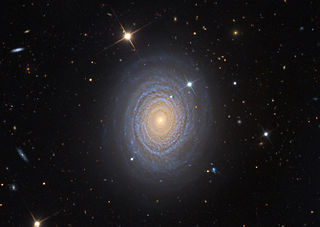
NGC 488 is a face-on spiral galaxy in the constellation Pisces. It is at a distance of about 90 million light-years away from Earth. Its diameter is estimated to be 52,6 Kpc. The galaxy has a large central bulge, and is considered a prototype galaxy with multiple spiral arms. Its arms are tightly wound. Star forming activity has been traced within the arms. The nucleus of NGC 488 has been found to be chemically decoupled, being twice as metal rich as the central bulge of the galaxy. NGC 488, with the exception of its smaller companions, that form NGC 488 group, is an isolated galaxy.

NGC 6394 is a barred spiral galaxy located in the constellation Draco. It is designated as SBb in the galaxy morphological classification scheme and was discovered by the American astronomer Lewis A. Swift on 7 July 1885.

















